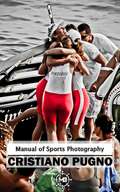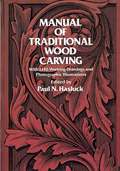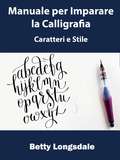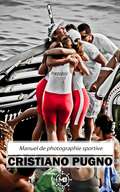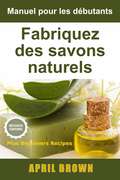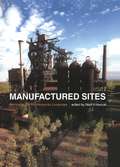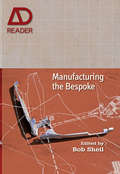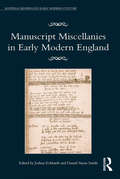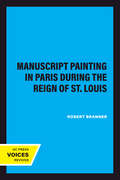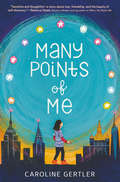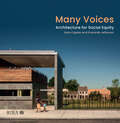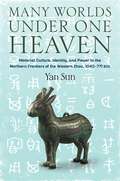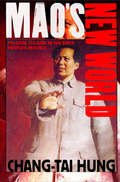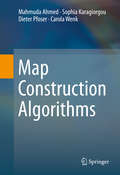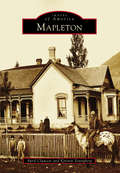- Table View
- List View
Manual of Sports Photography
by E. S. Dempsey Cristiano PugnoThe Manual of Sports Photography is a handbook about taking excellent sports photos. Cristiano Pugno is a professional photographer who has made a short guide to getting the best action shots, whether it be in soccer (football), running, gymnastics, or water sports. Keep this little manual with you when you are shooting athletic events; it will help you take front-page photos.
Manual of Traditional Wood Carving
by Paul N. HasluckDo you want to make an exact replica of a 16th-century carved table? Perhaps, an armchair in carved oak? Maybe, a misericord seat or a 17th-century chair. What about an Italian cassone or coffer, or an ornate 19th-century pipe rack? This book will show you how to make these and many other projects. The book combines practical instruction with numerous photographic illustrations and working diagrams. The summation of years of research and practical work, this volume is the definitive work in English on the craft of traditional wood carving.For the serious-minded beginner, the instructional content is well-organized, easy-to-follow, and very precise. The authors begin with the basics: what tools and appliances are necessary, what woods to use, instruction in the actual cutting of wood. There are chapters on how to translate your ideas into wood, how to design, trace or outline your project. The various methods of practical carving are described; incised, pierced, and chip carving; carving in the round; Gothic carving; styles of carved ornament; etc. Many specific projects are offered: from the simplest — small boxes, bread platters, chests, chairs and stools — to the more complex — tables, cupboards and cabinets, beds, sideboards, even staircases, or for that matter, almost any item you can imagine in wood.Authoritative, complete, and profusely illustrated with 1,146 working drawings and photographic examples, it contains a wealth of encyclopedic information. There is much here you could find nowhere else.
Manuale Photoshop per principianti: Tutorial, elementi, arte, sfondi, design, strumenti, & altro
by Hiddenstuff EntertainmentUn manuale dettagliato per imparare ad editare su Photoshop Questo manuale ti aiuterà ad imparare a conoscere gli strumenti di Photoshop, i loro utilizzi, i pannelli di livello ed i colori. Basato su ricerche dettagliate, questo libro ti insegnerà a: - Creare set con gli strumenti migliori - Controllare i pannelli di livello - Usare diversi formati per stampare - Pennelli, schemi ed ombre - Alterare i colori con i livelli di regolazione - Utilizzare lo strumento penna - Le scorciatoie tramite tastiera Se vuoi imparare le basi dell'editing su Photoshop, allora questo libro è per te. --> Vai in cima alla pagina e clicca su aggiungi al carrello per acquistarlo immediatamente Disclaimer: This author and or rights owner(s) make no claims, promises, or guarantees about the accuracy, completeness, or adequacy of the contents of this book, and expressly disclaims liability for errors and omissions in the contents within. This product is for reference use only.
Manuale per GoPro Hero & Fusion
by Hiddenstuff EntertainmentImpara ad usare la tua GoPro come un professionista! Questo manuale è per chiunque voglia ottenere fantastici video e foto con la sua GoPro. Compatibile con GoPro Fusion, Hero 4,5,6, & 7. Questo libro copre tutti gli argomenti che dovresti sapere: - Fare foto e video meravigliosi - Foto in time-lapse - Foto ruotate - Condividere foto e video - Fotografia subacquea - Composizione di video - Utilizzo della batteria - Risoluzione e campi visivi - Utilizzo dello stabilizzatore - Tecniche di video editing - E MOLTO ALTRO! Disclaimer: This author and or rights owner(s) make no claims, promises, or guarantees in regards to the accuracy, completeness, or adequacy of the contents of this book, and expressly disclaims liability for errors and omissions in the contents within. This product is for reference use only. Please consult a professional before taking action on any of the contents found within.
Manuale per Imparare la Calligrafia: Caratteri e Stile
by Hiddenstuff EntertainmentIn un'epoca in cui la maggior parte dei nostri scritti viene prodotta al computer, la Calligrafia ci permette di essere unici ed esprimerci nel nostro stile personale. In questo libro, Maggie svela la bellezza di un'arte e come puoi controllarla per esprimerti. In questo libro: -Stili popolari da esplorare ed adattare al tuo tocco personale -Scegliere gli strumenti adatti per creare una scrittura bellissima -Esempi specifici per aiutarti ad ispirare la tua personale forma d'arte -Dove acquistare gli strumenti -Selezione di pennini, inchiostri e carta -Far pratica con i tratti, le parole e le lettere --> Scorri verso l'inizio della pagina e clicca aggiungi al carrello per acquistare immediatamente Disclaimer: This author and or rights owner(s) make no claims, promises, or guarantees about the accuracy, completeness, or adequacy of the contents of this book, and expressly disclaims liability for errors and omissions in the contents within. This product is for reference use only.
Manuel de photographie sportive
by Cristiano Pugno SbCe manuel de photographie sportive offre les conseils de base pour réaliser de bons reportages sportifs. Les grandes lignes générales sont exposées et également les informations spécifiques pour quelques sports très populaires (football, gymnastique etc.) L'auteur aborde également les questions de l'editing.
Manuel pour les débutants Fabriquez des savons naturels: Comment fabriquer des savons doux naturels 100% élaborés par vos soins
by April BrownCe qui est génial lorsque l’on fabrique son propre savon c’est que l’on choisit ses ingrédients et ses parfums. Fabriquer ses savons à la maison est ludique et intéressant. Si vous ne vous êtes jamais lancé, essayez une des recettes et vous serez étonné que ce soit aussi facile. La seule chose à garder à l’esprit c’est qu’il faut suivre minutieusement les mesures et poids – c’est ce qui va déterminer le résultat du produit fini. Les ingrédients pour fabriquer du savon (soude et matières grasses / huiles) sont transformées par un processus chimique simple qui lie ces deux ingrédients en un nouvel élément – le savon après un processus appelé saponification. Chaque savon commence avec la soude. Pour fabriquer des savons artisanaux, vous devez toujours utiliser de la soude à 100% (hydroxyde de potassium ou hydroxyde de sodium) – pas de substitution. Ce qui est étonnant c’est que dans le produit fini, il ne reste plus de soude. Dans ce livre, je vous instruis sur le B.A. BA de la fabrication du savon, les équipements nécessaires, je vous donne en détails les différentes méthodes pour fabriquer vos savons avec des illustrations photos. Dans ce livre, vous avez : Jusqu’à cinq façons de fabriquer des savons Des recettes pour des usages différents Historique de la fabrication du savon Terminologie du savon Des recettes pour débuter Les précautions à prendre pour manipuler la soude Fabriquer des savons liquides . Télécharger votre E livre en cliquant ci-dessous "Achetez maintenant avec 1 click" button!
Manufactured Sites: Rethinking the Post-Industrial Landscape
by Niall Kirkwood**This title was originally published in 2001. The version published in 2011 is a PB reprint of the original HB** Manufactured Sites focuses on the legacy of industrial production and pollutants on the contemporary landscape and their influence on new scientific research, innovative site technologies and progressive site design. It presents innovative environmental, engineering and design approaches along with ongoing research and built projects of international significance. Contributions range from innovative scientific engineering research from industry and federal agencies to contemporary international and regional professional reclamation and redevelopment projects such as the 2000 Olympic Games in Sydney, Australia and the A.G. Thyssen steelworks and blast furnace planning in Germany's Ruhr region.
Manufacturing the Bespoke
by Bob SheilThe essential reader on fabrication in architecture for practitioners and producers alikeAn original and informative reader on the subject of translating architectural ideas from conceptual propositions to physical manifestations, Manufacturing the Bespoke is an essential resource for students and practitioners of architecture, as well as producers and suppliers of architectural products. At a time where roles, methods and capabilities within the disciplines of building production are in unprecedented flux, this book:Provides a unique and highly current treatment on the subject of fabrication in architecture with its emphasis on contemporary technology, cultural history and theoryA key source book for students and professionals engaged in manufacturing/fabrication projectsIncludes extended articles by internationally renowned critics, theorists, educators and designers, such as Mathias Kohler, Nevi Oxman, and Michael StaceyArticles will examine and refer to key portfolios of the 20th and 21st Century including works by Pierre Charreau, Peter Salter and Rural StudioFeaturing essays from pioneering architects, engineers, academics and designers from around the world on both existing and yet-to-be-built projects, the book covers architecture across the ages.
ManusCrypt: Designed for Mankind – Anthropocentric Information Security
by Prashant A UpadhyayaInformation security primarily serves these six distinct purposes—authentication, authorization, prevention of data theft, sensitive data safety / privacy, data protection / integrity, non-repudiation. The entire gamut of infosec rests upon cryptography. The author begins as a protagonist to explain that modern cryptography is more suited for machines rather than humans. This is explained through a brief history of ciphers and their evolution into cryptography and its various forms. The premise is further reinforced by a critical assessment of algorithm-based modern cryptography in the age of emerging technologies like artificial intelligence and blockchain. With simple and lucid examples, the author demonstrates that the hypothetical "man versus machine" scenario is not by chance, but by design. The book doesn’t end here like most others that wind up with a sermon on ethics and eventual merging of humans with technology (i.e., singularity). A very much practicable solution has been presented with a real-world use-case scenario, wherein infosec is designed around the needs, biases, flaws and skills of humans. This innovative approach, as trivial as it may seem to some, has the power to bring about a paradigm shift in the overall strategy of information technology that can change our world for the better.
Manuscript Miscellanies in Early Modern England (Material Readings in Early Modern Culture)
by Joshua Eckhardt Daniel Starza SmithPerhaps more than any other kind of book, manuscript miscellanies require a complex and ’material’ reading strategy. This collection of essays engages the renewed and expanding interest in early modern English miscellanies, anthologies, and other compilations. Manuscript Miscellanies in Early Modern England models and refines the study of these complicated collections. Several of its contributors question and redefine the terms we use to describe miscellanies and anthologies. Two senior scholars correct the misidentification of a scribe and, in so doing, uncover evidence of a Catholic, probably Jesuit, priest and community in a trio of manuscripts. Additional contributors show compilers interpreting, attributing, and arranging texts, as well as passively accepting others’ editorial decisions. While manuscript verse miscellanies remain appropriately central to the collection, several essays also involve print and prose, ranging from letters to sermons and even political prophesies. Using extensive textual and bibliographical evidence, the collection offers stimulating new readings of literature, politics, and religion in the early modern period, and promises to make important interventions in academic studies of the history of the book.
Manuscript Painting in Paris during the Reign of St. Louis
by Robert BrannerThis title is part of UC Press's Voices Revived program, which commemorates University of California Press’s mission to seek out and cultivate the brightest minds and give them voice, reach, and impact. Drawing on a backlist dating to 1893, Voices Revived makes high-quality, peer-reviewed scholarship accessible once again using print-on-demand technology. This title was originally published in 1977.This title is part of UC Press's Voices Revived program, which commemorates University of California Press’s mission to seek out and cultivate the brightest minds and give them voice, reach, and impact. Drawing on a backlist dating to 1893, Voices Revived</DIV
Manutenção de Carros: Manual, Listagem, Dicas e Reparos para Qualquer Carro em Casa
by Hiddenstuff Entertainment- Você está procurando manter seu carro na melhor estado? - Você gostaria de economizar dinheiro em contas e reparos de automóveis? - Você gostaria de evitar reparos caros? Se você respondeu sim a alguma destas perguntas, então este guia é para você! Aprenda as dicas e truques para conservar seu veículo ou caminhão. Instruções simples e fáceis de ler, para iniciantes e profissionais. Certifique-se de que você não está esquecendo seus intervalos de manutenção e evite os reparos dispendiosos. Mantenha seu carro funcionando por milhares de quilômetros a mais e pague menos por reparos e manutenção. --> Role até o topo da página e clique em adicionar ao carrinho para comprar instantaneamente Aviso: Este autor e/ou proprietário(s) de direitos autorais não faz reivindicações, promessas ou garantias em relação à exatidão, integridade ou adequação do conteúdo desse livro, e expressamente se isenta da responsabilidade por erros e omissões nos conteúdos nele contidos. Esse produto é de uso referencial apenas. Por favor, consulte um profissional antes de tomar medidas acerca de qualquer um dos conteúdos presentes nesse livro.
Many Masks: A Life of Frank Lloyd Wright
by Brendan GillBiography of the great American architect Frank Lloyd Wright (1867-1959) is often described as the greatest of American architects--an opinion Wright was quick to agree with, objecting only to what he considered the lessening of his place in history implied by the adjective "American." His works--among them Taliesin North, Taliesin West, Fallingwater, the Johnson Wax buildings, the Guggenheim Museum--earned him a good measure of his fame, but his flamboyant personal life earned him the rest. Here Brendan Gill, a personal friend of Wright and his family and the architecture critic for the New Yorker Magazine, gives us not only the fullest, fairest, and most entertaining account of Wright to date, but also strips away the many masks the architect tirelessly constructed to fascinate and mislead his admirers and detractors. Enriched by hitherto unpublished letters and three hundred photographs and drawings, this definitive biography makes Wright, in all his creativity, crankiness, and zest, fairly leap from its pages.
Many Points of Me
by Caroline GertlerWhen Georgia finds a secret sketch her late father—a famed artist—left behind, the discovery leads her down a path that may reshape everything holding her family and friends together. Caroline Gertler’s debut is a story about friendship, family, grief, and creativity. Fans of Rebecca Stead’s Goodbye Stranger, Dan Gemeinhart’s The Remarkable Journey of Coyote Sunrise, and E. L. Konigsburg’s From the Mixed-up Files of Mrs. Basil E. Frankweiler will find a new friend in Georgia. Georgia Rosenbloom’s father was a famous artist. His most well-known paintings were a series of asterisms—patterns of stars—that he created. One represented a bird, one himself, and one Georgia’s mother. There was supposed to be a fourth asterism, but Georgia’s father died before he could paint it. Georgia’s mother and her best friend, Theo, are certain that the last asterism would’ve been of Georgia, but Georgia isn’t so sure. She isn’t sure about anything anymore—including whether Theo is still her best friend. Then Georgia finds a sketch her father made of her. One with pencil points marked on the back—just like those in the asterism paintings. Could this finally be the proof that the last painting would have been of her? Georgia’s quest to prove her theory takes her around her Upper West Side neighborhood in New York City and to the Metropolitan Museum of Art, which was almost a second home to Georgia, having visited favorite artists and paintings there constantly with her father. But the sketch leads right back to where she’s always belonged—with the people who love her no matter what.
Many Smokes, Many Moons: A Chronology of American Indian History Through Indian Art
by Jamake HighwaterWith emphasis on the tribes in North America, this book uses the art and artifacts of various Indian cultures to illustrate events affecting their history from earliest times through 1973.
Many Voices: Architecture for Social Equity
by Sara Caples Everardo JeffersonDo you know how to create beautiful buildings that truly promote social change? Architects need to understand how to design for social equity, but too often this is presented as a choice between work that does good and work that looks good. When done well, building for social equity can directly enhance the formal, experimental and creative language of architecture. Renowned architects Sara Caples and Everardo Jefferson, who have been designing for underserved multi-cultural communities in New York for decades, provide thought leadership that is deeply rooted in practice. By urging architects to approach equity projects with an open mind, the volume highlights the need to dig deep into the diverse culture of local neighbourhoods. It provides techniques to encourage listening, communicating and fully engaging with users, resulting in imaginative design responses that draw on all the tools that the architect possesses. Packed with interviews from established and up-and-coming designers, and highly illustrated case studies from all over the world, this accessibly written book serves both as a point of inspiration and a challenge to Western-centric ways of working. Ultimately, it explores how listening to the aspirations of diverse communities enriches designs and broadens the architectural language of all involved. Featuring: International case studies from Austria, Brazil, Bolivia, China, Egypt, India, USA and many more Interviews from leading designers, including: Tatiana Bilbao, Wanda Dalla Costa, Andres Lepik, Xu Tiantian, Li Xiaodong, Sara Zewde Guidance on a range of topics, from integrating narratives to working with colour, communicating with communities and stakeholders to ethical practice
Many Worlds Under One Heaven: Material Culture, Identity, and Power in the Northern Frontiers of the Western Zhou, 1045–771 BCE (Tang Center Series in Early China)
by Yan SunIn the mid-eleventh century BCE, the Zhou overthrew the Shang, a dynastic power that had dominated much of northern and central China. Over the next three centuries, they would extend the borders of their political control significantly beyond those of the Shang. The Zhou introduced a political ideology centered on the Mandate of Heaven to justify their victory over the Shang and their territorial expansion, portraying the Zhou king as ruling the frontier from the center of civilization. Present-day scholarship often still adheres to this core-periphery perspective, emphasizing cultural assimilation and political integration during Zhou rule. However, recent archaeological findings present a more complex picture.Many Worlds Under One Heaven analyzes a wide range of newly excavated materials to offer a new perspective on political and cultural change under the Western Zhou. Examining tombs, bronze inscriptions, and other artifacts, Yan Sun challenges the Zhou-centered view with a frontier-focused perspective that highlights the roles of multiple actors. She reveals the complexity of identity construction and power relations in the northern frontiers of the Western Zhou, arguing that the border regions should be seen as a land of negotiation that witnessed cultural hybridization and experimentation. Rethinking a critical period for the formation of Chinese civilization, Many Worlds Under One Heaven unsettles the core-periphery model to reveal the diversity and flexibility of identity in early China.
Mao Zedong’s “Talks at the Yan’an Conference on Literature and Art”: A Translation of the 1943 Text with Commentary (Michigan Monographs In Chinese Studies #39)
by Zedong Mao Bonnie S. McDougallThe writings of Mao Zedong have been circulated throughout the world more widely, perhaps, than those of any other single person this century. The “Talks at the Yan’an Conference on Literature and Art” has occupied a prominent position among his many works and has been the subject of intense scrutiny both within and outside China. This text has undoubted importance to modern Chinese literature and history. In particular, it reveals Mao’s views on such questions as the relationship between writers or works of literature and their audience, or the nature and value of different kinds of literary products. In this translation and commentary, Bonnie S. McDougall finds that Mao was in fact ahead of many of his critics in the West and his Chinese contemporaries in his discussion of literary issues. Unlike the majority of modern Chinese writers deeply influenced by Western theories of literature and society (including Marxism), Mao remained close to traditional patterns of thought and avoided the often mechanical or narrowly literal interpretations that were the hallmark of Western schools current in China in the early twentieth century. Many of the detailed discussions on the “Talks” in the West have been concerned with their political and historical significance. However, since Mao is a literary figure of some importance in twentieth-century China, McDougall finds it worthwhile to follow up his published remarks on the nature and source of literature and the means of its evaluation. By better understanding the complex and revolutionary ideas contained in the “Talks,” McDougall suggests we may acquire the necessary analytical tools for a more fruitful investigation into contemporary Chinese literature.
Mao's New World: Political Culture in the Early People's Republic
by Chang-tai HungIn this sweeping portrait of the political culture of the early People's Republic of China (PRC), Chang-tai Hung mines newly available sources to vividly reconstruct how the Chinese Communist Party (CCP) tightened its rule after taking power in 1949. With political-cultural projects such as reconstructing Tiananmen Square to celebrate the Communist Revolution; staging national parades; rewriting official histories; mounting a visual propaganda campaign, including oil paintings, cartoons, and New Year prints; and establishing a national cemetery for heroes of the Revolution, the CCP built up nationalistic fervor in the people and affirmed its legitimacy. These projects came under strong Soviet influence, but the nationalistic Chinese Communists sought an independent road of nation building; for example, they decided that the reconstructed Tiananmen Square should surpass Red Square in size and significance, against the advice of Soviet experts sent from Moscow.Combining historical, cultural, and anthropological inquiries, Mao's New World examines how Mao Zedong and senior Party leaders transformed the PRC into a propaganda state in the first decade of their rule (1949–1959). Using archival sources only recently made available, previously untapped government documents, visual materials, memoirs, and interviews with surviving participants in the Party's plans, Hung argues that the exploitation of new cultural forms for political ends was one of the most significant achievements of the Chinese Communist Revolution. The book features sixty-six images of architecture, monuments, and artwork to document how the CCP invented the heroic tales of the Communist Revolution.
Maori Tattooing
by H. G. RobleyOriginally published in 1896, this classic of ethnography was assembled by a skilled illustrator who first encountered Maori tattoo art during his military service in New Zealand. Maori tattooing (moko) consists of a complex design of marks, made in ink and incised into the skin, that communicate the bearer's genealogy, tribal affiliation, and spirituality. This well-illustrated volume summarizes all previous accounts of moko and encompasses many of Robley's own observations. He relates how moko first became known to Europeans and discusses the distinctions between men and women's moko, patterns and designs, moko in legend and song, and the practice of mokomokai: the preservation of the heads of Maori ancestors. Features 180 black-and-white illustrations.
Map Art Lab: 52 Exciting Art Explorations in Map Making, Imagination, and Travel (Lab)
by Jill K. Berry Linden McNeillyExplore the world of cartography with this collection of creative map-related projects—for artists of all ages and experience levels.This fun and creative book features fifty-two map-related activities set into weekly exercises, beginning with legends and lines, moving through types and styles, and then creating personalized maps that allow you to journey to new worlds. Authors Jill K. Berry and Linden McNeilly guide you through useful concepts while exploring colorful, eye-catching graphics.Maps are beautiful and fascinating, they teach you things, and they show you where you are, places you long to go, and places you dare to imagine. The labs can be used as singular projects or to build up to a year of hands-on creative experiences. Map Art Lab is the perfect book for map lovers and DIY-inspired designers. Artists of all ages and experience levels can use this book to explore enjoyable and engaging exercises.“Learn about cartography, topography, legends, compasses, and more in this adventurous DIY map book.” —Cloth Paper Scissors Magazine“Every art teacher should have a copy of this book.” —Katharine Harmon, author of The Map as Art: Contemporary Artists Explore Cartography
Map Construction Algorithms
by Mahmuda Ahmed Sophia Karagiorgou Dieter Pfoser Carola WenkThe book provides an overview of the state-of-the-art of map construction algorithms, which use tracking data in the form of trajectories to generate vector maps. The most common trajectory type is GPS-based trajectories. It introduces three emerging algorithmic categories, outlines their general algorithmic ideas, and discusses three representative algorithms in greater detail. To quantify map construction algorithms, the authors include specific datasets and evaluation measures. The datasets, source code of map construction algorithms and evaluation measures are publicly available on http://www. mapconstruction. org. The web site serves as a repository for map construction data and algorithms and researchers can contribute by uploading their own code and benchmark data. Map Construction Algorithms is an excellent resource for professionals working in computational geometry, spatial databases, and GIS. Advanced-level students studying computer science, geography and mathematics will also find this book a useful tool.
Maple Grove Cemetery (Images of America)
by Carl Ballenas Nancy CataldiMaple Grove Cemetery, a rural Victorian cemetery located on the backbone of Long Island," opened in 1875. Found within this tranquil sanctuary are extraordinary monuments with lush landscaping that continues to offer a serene escape from New York City. Beyond its gates are the resting places of those who left their mark on the world. Maple Grove Cemetery features the fascinating stories of such noteworthy individuals as Millie Tunnell, former 111-year-old slave; Ann Wilkins, one of the first female missionaries to Africa; John Sutphin, Queens politician and philanthropist; Samuel Loyd, America's puzzle king; Charles Manly, aviation pioneer; Alfred Grebe, radio and broadcast pioneer; Elisabeth Riis, wife of social reformer Jacob Riis; Russian pianists Josef and Rosina Lhevinne; and Blues singer Jimmy Rushing. The cemetery was placed on the National Register of Historic Places in 2004."
Mapleton
by April Clawson Kjirstin YoungbergLocated south of Provo and artistic Springville, Mapleton was named in 1901 for its abundance of colorful maple trees. For centuries, American Indian tribes had regarded the bench overlooking Hobble Creek and the valley below as sacred ground and gathered there annually. Catholic explorers hiking down Spanish Fork Canyon, nestled beneath a majestic mountain, first mapped the area in 1776. These Spaniards named the peak Sierra Bonita, though nearly everyone today calls it Maple Mountain. By 1850, Mormon pioneers had settled in Springville, using the rich earth between the creek and the river as farmland. Little by little, they built homes and stayed. The continued perseverance of this community to maintain its country charm is evident throughout the city. Conservation of the foothills and open spaces is an ongoing concern to residents.
